In Part I, we covered the first thirty years of Fiat, from its inception in 1899 to 1931. This week we take the story to the death of Giovanni Agnelli shortly after WWII.

The 514 MM, the first in a long line of models designated "MM" for Mille Miglia. The car in the photo is actually a "Coppa delle Alpi". and was identical to the MM aside from a shorter wheelbase. Siata offered a overhead valve conversion for the car
|
1932-1945
Fiat may have retired from racing in 1927, but suddenly it seemed that everyone was racing Fiats. As Fiat withdrew from the Grand Prix circuits, the Mille Miglia began, and the promoters encouraged the entry of small displacement touring cars. The 514 model, (1929-1932) which was a 1500cc upgrade of the popular 509, was a very successful sports model. It was also the last Fiat
with mechanical brakes.
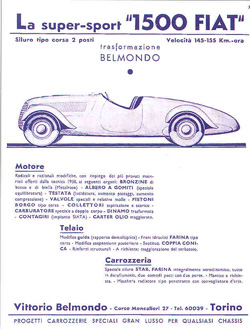
The 1500s were a staple of the early Mille Miglias. Here is a super sport version with Stablimenti Farina
coachwork, put together by an enterprising Vittoria Belmondo.
|
Mille Miglia, Mussolini, Mickey Mouse
and the Millicento
Despite the worldwide depression, and a nearly 50% reduction in total automobile production from 1927 to 1931, Fiat introduced a new range of highly successful small cars. Notably, the 2800 of 1938 was the largest Fiat produced, and only 621 units were built, compared to 122,000 500s produced from 1936 to 1948.
The introduction of the Balilla in 1932 (shown first to Mussolini on April 8th) created a sensation and new speed industry. Named after a Fascist youth organization, the Balilla, or 508, was a straightforward yet charming small car, with a side valve, front engine of 995 cc, which initially produced 20 hp with a three speed transmission. It
was a Ford Model A in miniature, simple, easy to work on and easy to modify.
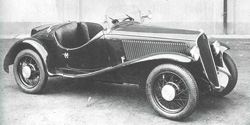
The 508S Balilla of 1933 had a Ghia body, a three speed transmission. The "CS" in 1934 had an overhead valve engine of 995cc and 36 hp with a four speed. The Spider Sport (often referred to as a Mille Miglia), seen here, had cycle fenders while the Coppa d’Oro had long, sweeping fenders.
|
One year later the Balilla Sport, was introduced, in both spider and coupe form. If the Balilla sedan was a scaled down Model A, the Sport Spider (by Ghia) was a scaled down Alfa 1750 Zagato, which at the time was one of the finest cars not only in Italy but the world. The Italians went crazy. Here was a car that looked like a billion lire, performed admirably, and cost a fraction of the Alfa. The Mille Miglia became the playground for hundreds of Balillas, would-be Nuvolaris (including the Villoresi brothers).
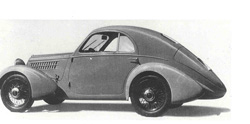
The Ballila aerodynamic coupe version, was officially known as the Mille Miglia. Siata offered a supercharged version capable of 95 mph.
|
The Mille Miglia organizers attempted to have a multitude of classes, including a 1100 cc class, but failed to reckon that Maserati would create a supercharged 1100cc racing car which, almost dominated the class until 1936. The situation was resolved in 1936 by creating an 1100cc un-supercharged class, duly won by a Balilla. In 1937, out of 145 entries, 86 were Fiats of varying displacements. In 1938 there were 38 1100cc Fiats in that class alone.
M-i-c-k-e-y M-o-u-s-e
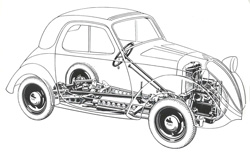
Cutaway of the Topolino illustrates the backbone chassis frame, forward front engine and the unique high radiator. The front suspension was independent with wishbones and transverse springs.
|
But the Balilla, at a little less than one liter, was not small enough. In 1936, Vittorio Valletta, already the General Manager of Fiat, was preparing an even smaller car for the masses. It was designated the 500, following the 5 series pattern of earlier Fiats. The displacement was close as well, at 569 cc. It became known, unofficially, as the Topolino—meaning little mouse in general and Walt Disney’s Mickey Mouse in particular. Along with the larger 1500 model, also the 500 featured a backbone chassis with independent front suspension. It was very advanced for 1936, and was targeted to "the least well endowed social classes." Whatever the targeted market, the Topolino was destined to become a landmark car not only in Italy, but in many other countries where the Fiats were imported.
It may have been Valetta’s idea, but it was a young engineer by the name of Dante Giacosa whose design was accepted for production. The brilliant Giacosa would stay at Fiat until his retirement in 1970.
The Immortal Millicento
The Balilla was enlarged to 1100 cc (1089cc) with the 508C of 1937, and the old sidevalve was replaced with an overhead valve design. The most interesting of the 508C models was the MM, again for Mille Miglia. It featured a full envelope body, faired in headlights and a very pointed tail. With 42 hp, it developed 10 more than the standard 508C, and was very successful on Italian racing circuits.
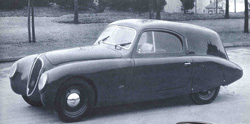
Perhaps lacking some grace, the Fiat 508C MM broke class records with a speed of 69.59 mph for over 1000 miles in the 1938 Mille Miglia, and top speed was almost 90 mph.
|
In 1939, the Balilla name was dropped, and a restyled 1100 cc sedan was introduced, and the basic car remained in production until 1953. More than 157,000 1100s were made. The Millicento, in various configurations, was to last for the next years.
The Balilla, Topolino, and 1100 launched hundreds of small racecars, which today are called the Etceterinis. In 1937, a national championship was created with classes for 750 and 1100 cc sports racers, and the creativity of the Italian small garages was unleashed. Names like Siata, Stanguellini, Abarth, Bandini, grew from backyard shops to worldwide fame, all based on humble Fiat components.
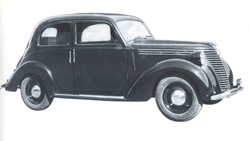
Although the 1100 was in reality a modernized Ballila, the 1939 model lasted until it was replaced with the unit-bodied "Nuovo" 1100 in 1953.
|
With these three models, Fiat survived the depression, Mussolini, WWII and had a basis for the post war prosperity. By 1939, Giovanni Agnelli, still very much at the helm, nevertheless appointed Vittorio Valetta as the Managing Director, a post which held real power at Fiat.



